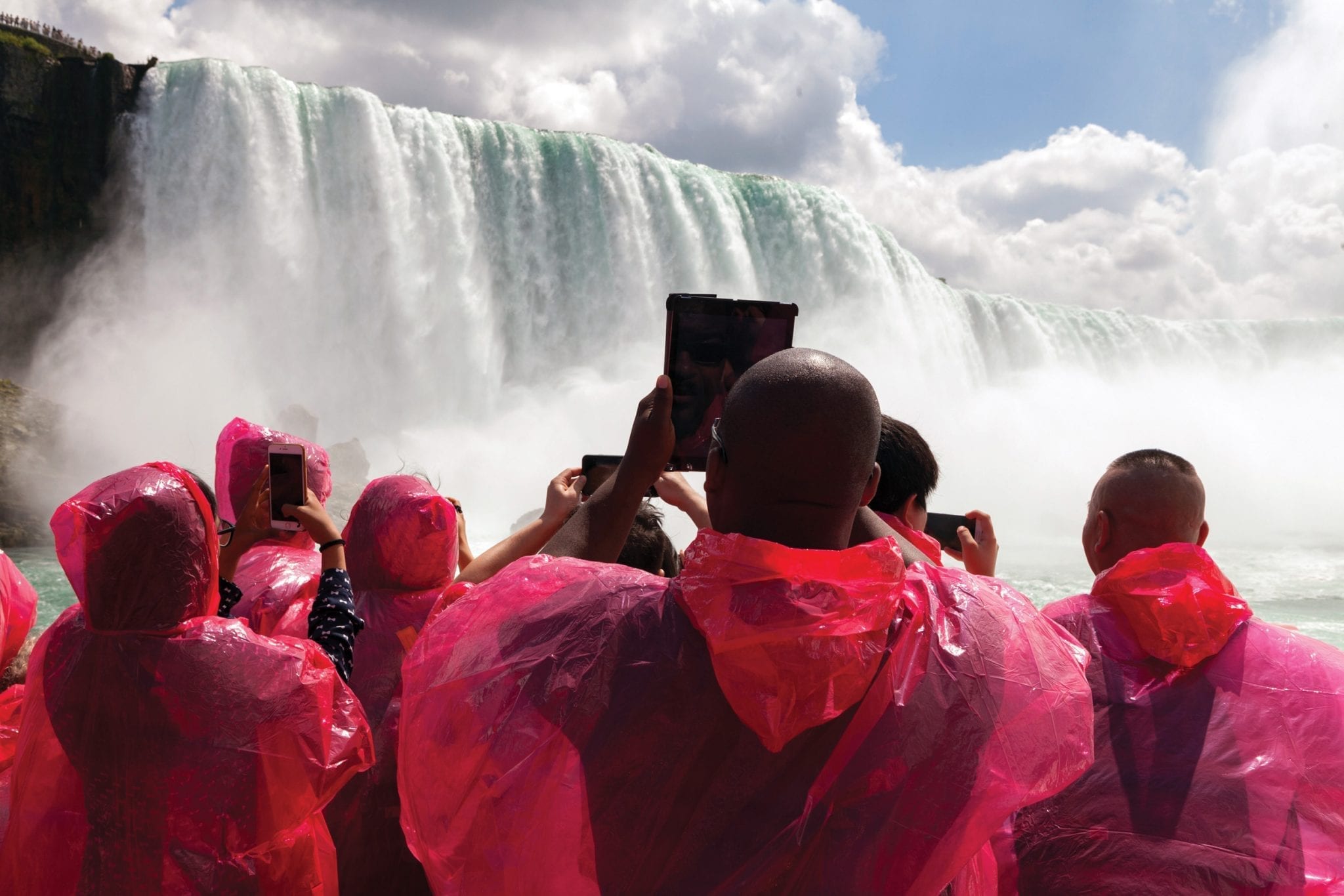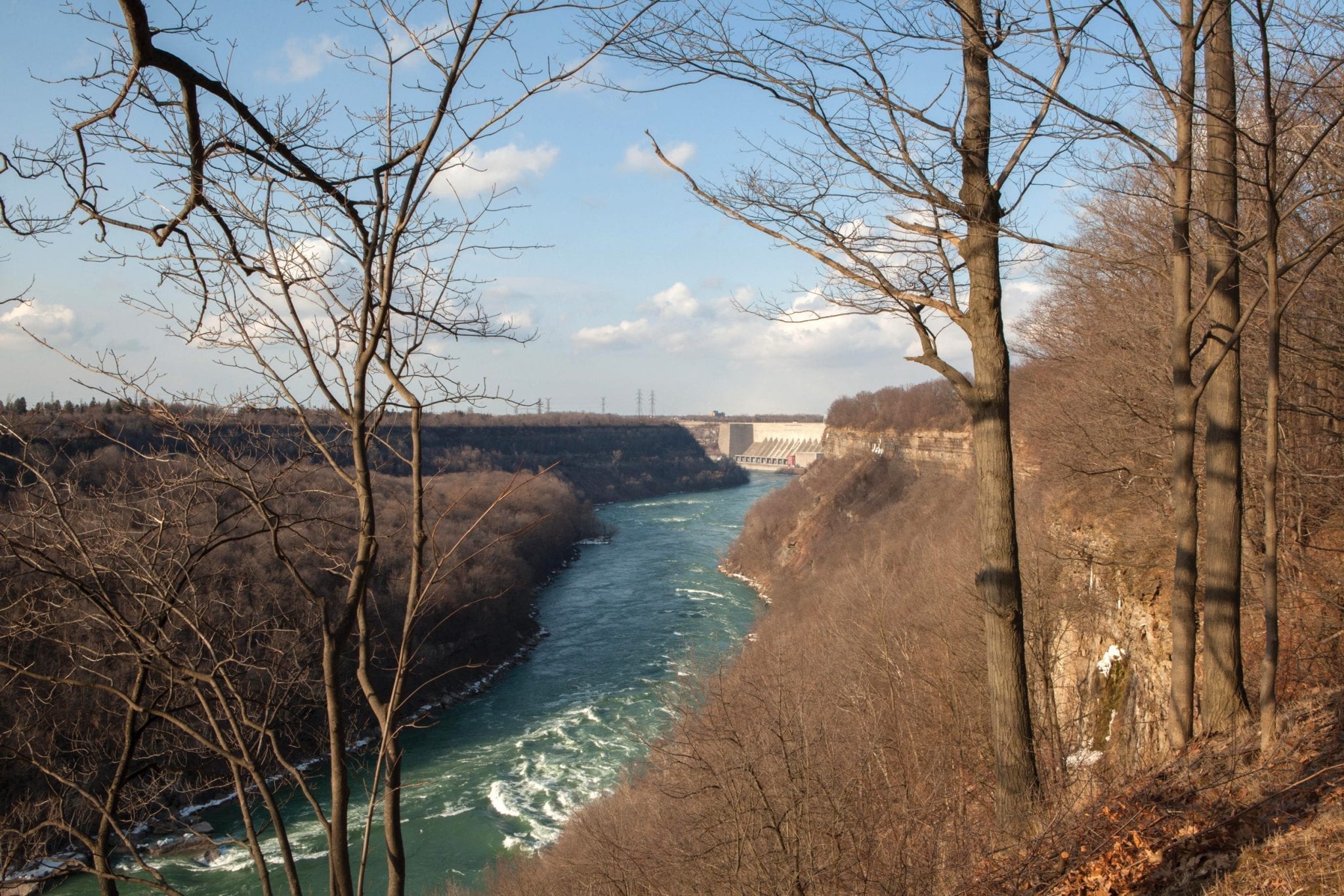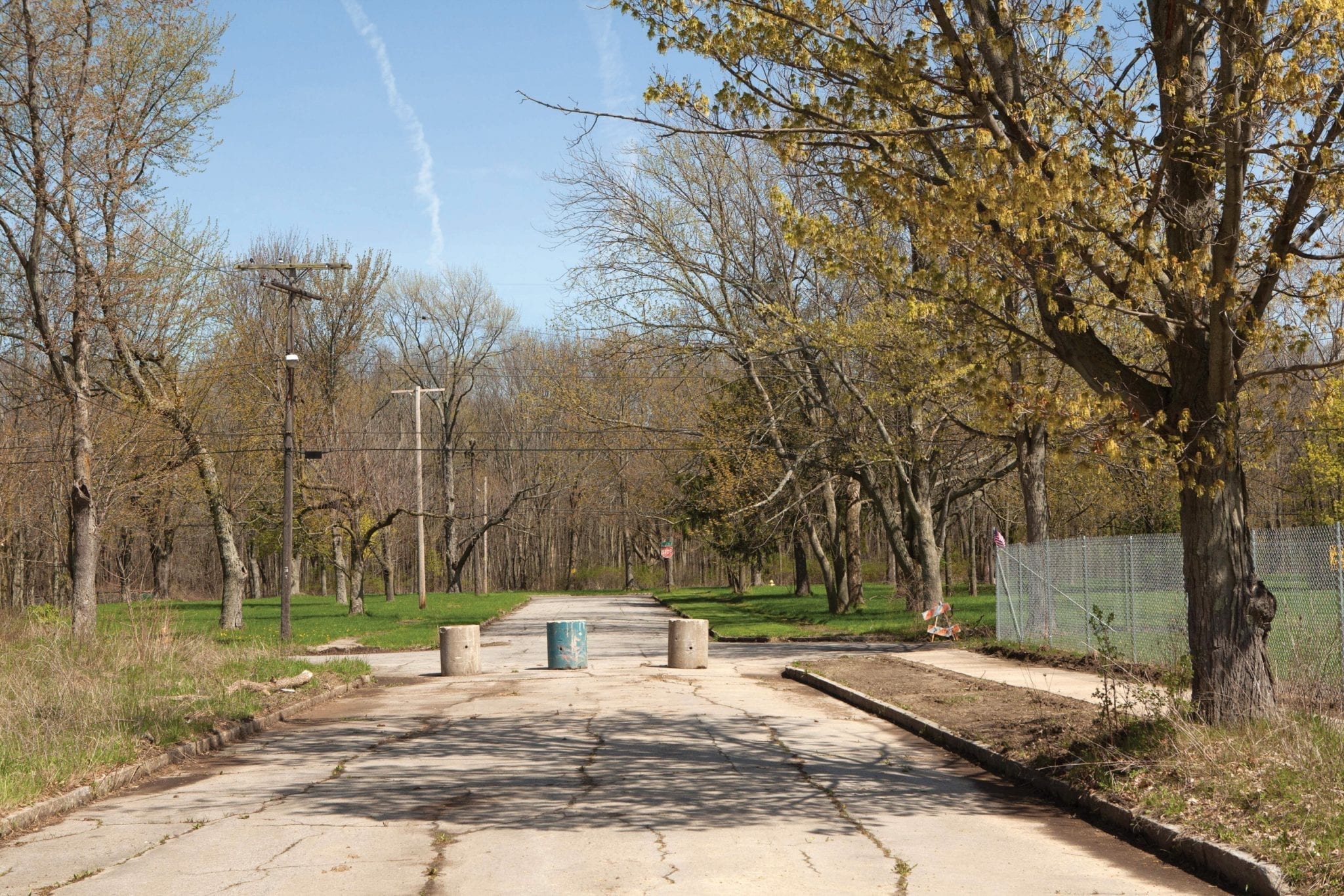Turning off the Falls
The drive to tame the wild waters of Niagara Falls has had devastating unintended consequences on the environment and society – all in the name of progress and the quest for more green dollars. This is the story of innovation, energy, greed, waste, power, nature and our role as humans in trying to control absolutely everything, as told by collaborators Alan Gignoux and Jenny Christensson as part of their project Human Accumulations.
At midnight on 16 November 1896, Edgar Boardman Jewett, Mayor of Buffalo, pulled a power switch and in doing so, made history. Electricity produced by turbines at Niagara Falls at the Westinghouse power generation plant was successfully transmitted some 20 miles downriver using Nikola Tesla’s then ground-breaking alternating current technology. The modern era of electricity had begun.
Jewett and his entourage, nervous that the transmission would fail, scheduled that epochal moment for the middle of the night and left it unadvertised to avoid a potential public relations disaster. They need not have worried. As Tesla himself had confidently proclaimed, the principles behind his discovery were “as firmly established as the air itself.”
To be fair, the mayor had some reason to be worried. The development of hydro-electric power at Niagara Falls was peppered with ambitious, but ultimately failed, projects.
Power generation at Niagara Falls began in 1758 when the French colonists introduced saw mills using Niagara water above the crest. Approximately one hundred years later advances in technology encouraged entrepreneurs to seek a means by which the immense power of the Falls could be used to generate electrical power. By 1885, the strip of land running alongside the river just above the American Falls, as well as Goat Island, had been appropriated by the State of New York and declared a preservation area, forcing engineers to find a means by which the power of the Falls could be harnessed without access to the water at the riverbank. In 1886, Thomas Evershed, the divisional engineer of the New York State canal system, devised a solution that involved boring a tunnel to carry water from a point above the Falls to a discharge point far below.
Evershed’s ambitious project solved the problem of shoreline access but the immense cost of the project ($1.4 million – equivalent to $42.4 million today) frightened off investors. Even if the engineering challenge could be met, there were insufficient customers locally to warrant the investment. Edison’s direct current, the prevailing technology of the time, could not transmit electricity over large distances. Until a means of transmitting the electrical power generated at Niagara Falls to nearby Buffalo (and beyond) was found, the project could not go ahead.
In the competition for the contracts to participate in the development, transmission and distribution of power generated at Niagara Falls proposed by the International Niagara Commission, the established North American inventor Thomas Edison and the young Serbian upstart Nikola Tesla, backed by Westinghouse, went head-to-head in a battle over Edison’s direct current and Tesla’s alternating current. In the end, the commission backed Tesla’s technology and the future of electricity was secured.

Electro-chemicals production
Entrepreneurs lost no time in taking advantage of cheap power at Niagara Falls. By the end of the 1890s, 11 major companies had arrived in the city and by 1909 the number had risen to 25. Within a decade, Niagara Falls became the center of the nascent electro-chemical and electro-metallurgical industries in the USA. The companies that arrived in the Falls at that time merged to become industrial giants with household names: Union Carbide, Anaconda, American Cyanamide, Auto-Lite Battery and Occidental Petroleum.
One of the leaders of the chemicals industry at the Falls was Elon Hooker, the founder of Hooker Chemical. The chemicals produced at Hooker, including bleaching powder, caustic soda, degreasers, rubbers, explosives, defoliants and plastics, “helped win wars, explore space, and fuel American consumerism.” 6 Between 1939 and 1950, company sales increased 390% and net income by 850%.
One important consequence of Hooker’s enormous expansion was the issue of chemical waste disposal. In the first few decades of the twentieth century, industries at Niagara Falls had disposed of the by-products of their chemical production by burying them in containers on their industrial properties. From the 1940s, Hooker’s on-site disposal capacity was overwhelmed. With the permission of the city, in 1942 they began a massive burial operation a Love Canal – a disused, partially completed section of canal on the outskirts of the city, and the remnant of a failed Utopian project that was the brainchild of a nineteenth century entrepreneur called William Love. Over the course of the next decade, Hooker deposited roughly 22,000 tons of chemical sludge in steel drums at the site.

Unintended consequences
Back in the 1950s and ’60s, the now unoccupied blocks between 97th and 103rd Streets in Love Canal were home to 950 families. Tree-lined streets with affordable, suburban-style housing were within easy commuting distance to the city’s thriving chemicals factories. It was a happy, hard-working and prosperous community. Life in this idyll changed irrevocably in the 1970s. After heavy rains, basements in the neighbourhood were flooded with a foul-smelling black sludge. Children playing in the school playground and in and around the nearby creeks suffered burns. The bark began to peel off trees and gardens and vegetable plots withered and died. Residents complained of serious medical problems, including epilepsy, liver disease, rectal bleeding, miscarriages and birth defects.
The source of these problems was traced back to a buried section of canal at the heart of the neighbourhood. Thirty years after Hooker had started using the Love Canal site as a landfill, the rusting and leaking drums of waste had started to surface. Local residents at Love Canal, led by housewife Lois Gibbs, staged a protracted grassroots campaign initially seeking evacuation and compensation. Over time, their activities took on a wider significance as the Love Canal activists began to see their struggle as a fight for environmental justice. “Love Canal was not just a national, but a global story,” says Paul Dyster, Mayor of Niagara Falls, New York, in an interview with the author. “At one level, it was a catastrophe. On the other hand, it gives us the opportunity to claim that the modern environmental movement, as we understand it globally, was really born here at Niagara Falls.” In December 1980, US Congress approved the Comprehensive Environmental Response, Compensation and Liability Act (CERCLA), commonly known as Superfund. It made substantial government funds available for the immediate clean-up of the most harmful hazardous waste sites, while also allowing for the government to identify and seek compensation from those responsible for the waste. Love Canal was named as priority number one, on the National Priority List (NPL) of sites identified as most urgently in need of attention.
This was only the beginning.

The nature of the beast
It is misleading to talk in terms of “cleaning-up” a Superfund site. The most common form of remediation is containment – sealing the affected area off and closing it with a clay cap. Superfund sites are removed from the NPL list when the remedial system has been put in place and the only remaining activity is monitoring. Today, Niagara Falls is home to 89 Superfund sites, of which two are active NPL sites, 14 are active non-NPL Superfund sites and 73 are archived sites.
All over the city there are unmarked, fenced off areas containing large grassy mounds. These are dotted with monitoring wells in the form of yellow pipes that protrude from the ground forming the four corners of a square, or black pipes that pop out here and there like periscopes from underground submarines. While the aim of remedial action is to prepare the land for re-use, the sites with the worst history of contamination have limited future use possibilities. Of the five NPL Superfund sites within the city limits of Niagara Falls, only one has any recorded redevelopment.
It seems unimaginable that 85,000 cubic feet/sec of 3,160 tons/sec of water can be controlled.
There are also many acres of brownfield sites, and land scarred by disused and rotting factories. Environmental regulations introduced after the Love Canal disaster chased away the chemicals industries that sustained the Niagara Falls economy, creating mass unemployment and accelerating the city’s decline from boom town to Rustbelt casualty. If Niagara Falls is to move beyond its post-industrial present it needs to repurpose its land.

Tom DeSantis, Acting Director of Planning and Economic Development at Niagara Falls, thumps the table in his office repeatedly with the sides of his hands to underline his arguments: “The problem is that the land that doesn’t get used tends to stay fallow. And while the current multinational chemicals companies will tell you they never mothball property, it’s something they don’t do – they, in fact, do it all the time. They don’t want to deal with the environmental regulations that would apply… it’s clean up for future use.”
Under current legislation liability for cleaning-up polluted sites lies with the perpetrator. For this reason, many companies prefer to do nothing with their properties, rather than clean-up and sell. This problem affects many sites in the city – in particular those along the river above the Falls in the once world-renowned industrial area known as Buffalo Avenue. DeSantis says: “We have this kind of place that’s known for nature, parks and all of that. And we also have this place that’s known for pollution and Superfund sites and… Love Canal. How can these things exist simultaneously? But they do and that’s just the nature of the beast that we deal with.”
The modern environmental movement, as we understand it globally, was really born here at Niagara Falls.
– Paul Dyster, Mayor of Niagara Falls
In 1969, the flow of water over the Falls was stopped entirely exposing the rockface beneath. It seems unimaginable that 85,000 cubic feet/sec or 3,160 tons per second of water can be controlled, let alone stopped in its tracks, but the engineering method used to achieve this is straightforward.
Now, there are plans in motion to stop the flow of water over the Falls once again so that engineers with the New York State Office of Parks, Recreation, and Historic Preservation can scrap two 115-year-old bridges that have reached the end of their useful lives. The works are proposed to take place in 5-7 years at an estimated cost of $3 million. Officials anticipate that when the day arrives, turning off the Falls will draw crowds in the thousands. The sight of human ingenuity taming the beast of Niagara still has the power to stir the imagination; but the beast was tamed many years ago and we – not nature – became the engineers of our own misfortune.